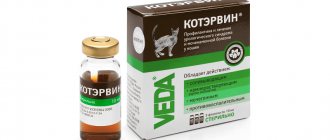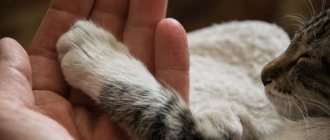Domestic cats and dogs have a similar reproductive system. In cats, the reproductive organs are represented by the uterus, which has two horns, ovaries, fallopian tubes and vagina.
The occurrence of spotting or blood from the loop area in a cat is a cause for concern. Diseases in the renal system can also cause bleeding in a pet.
Some owners are not alarmed when they notice bloody discharge from a cat’s snare, believing that this is the period of sexual heat. But unlike dogs, during estrus a cat should not produce bloody exudate from the vagina.
Physiologically caused bloody discharge in cats are those that appear in the period before the onset of the birth process and several weeks after.
Otherwise, if the owner notices blood on the litter or on the cat’s genitals, it is necessary to contact a veterinary clinic for help. At home, it is not possible to determine the exact cause of the appearance of blood. Any delay can cause the death of the cat.
How dangerous is this?
Many owners believe that spotting in cats occurs due to pathologies of the urinary system. Indeed, the symptom may indicate inflammation or the formation of stones. Such diseases often lead to death. Therefore, if illness appears, it is important to show the animal to a veterinarian as quickly as possible. Often, spotting in cats occurs due to an improper diet.
A lack of iron and other important substances in food negatively affects the pet’s well-being, leading to deterioration and metabolic disorders. However, there are cases when such a symptom is the result of natural changes occurring in the animal's body. But this does not mean that you need to independently draw conclusions about the reason for its appearance. To establish the correct diagnosis, you must consult a veterinarian.
Normal changes that occur in the body
In some cases, bloody discharge is observed in a cat for reasons related to natural processes. Such circumstances do not pose a threat to the health of the animal. Such changes include the following:
- Estrus. This process is accompanied by an increase in the pet’s activity. The female often arches her back, rolls around on the floor, and becomes playful. It is absolutely normal for a cat to have bloody discharge during estrus. After this period ends (as a rule, this happens after a few days), the symptom disappears completely.
- Bearing offspring. The presence of this sign in a pregnant female indicates a restructuring of the body and preparation for the birth of cubs. However, intense discharge indicates the development of serious pathological processes.
Estrus and discharge
Estrus, or estrus, is a period of sexual activity in a cat. It is not cyclical, like menstruation, and occurs immediately after puberty. It varies for different cats, from six months to a year. Once puberty ends, the cat is ready to mate and begins to behave accordingly. This condition is called estrus. The estrous or reproductive cycle is a time period when the specifically designed organism of a feline is physiologically ready to mate, conceive and bear kittens.
How long it can last depends on certain circumstances, but you can definitely count on a week. It is believed that with the normal development of a cat, estrus should begin closer to the age of one, and if estrus starts earlier, such females are unsuitable for breeding. The first estrus can begin earlier, but this is considered a sign of increased hormonal activity or endocrine disruption, which can be inherited.
Dangerous diseases
There are situations when bleeding indicates serious illness. This symptom should not be ignored, as it can manifest itself under the influence of the following circumstances:
- The process of decomposition of the placenta. After giving birth, a cat's bloody discharge, which has a liquid consistency, indicates that the remains of the placenta have not left the animal's body. Most likely, the pet will require surgical intervention.
- Infectious processes occurring in the genitals. Thick light red discharge often occurs in females with pathologies of the urinary system and uterus.
- Malignant neoplasms. The leakage of blood and pus is a characteristic sign of cancerous tumors of the reproductive system. As a rule, with this pathology, the discharge has an unpleasant odor.
- Inflammatory processes occurring in the genitals, for example, in the vagina. Such diseases are accompanied by difficulty urinating, aggression and anxiety. The cat often licks the lower part of its body. This symptom indicates that the animal is feeling severe discomfort.
Causes and signs of uterine bleeding in a cat
Bleeding from the uterus is divided into two types - hidden and open. The closed type of uterine bleeding is characterized by a closed cervix, which leads to the inability of blood to find its way out.
The released blood accumulates in the cavity, causing the pet to develop lethargy, problems with activity, and loss of appetite. In some cases, there are breathing problems (shortness of breath) and a decrease in overall body temperature (cold paw pads).
If the owner carefully palpates the abdomen, an increase in the abdominal cavity in size, as well as tension in the abdominal wall, can be noted.
Extensive internal hemorrhages lead to iron deficiency anemia, as well as discoloration of the visible mucous membranes. Internal uterine bleeding develops gradually.
In some cases, blood can accumulate for a long time, up to several weeks, and sometimes within 48-72 hours.
Regarding the open type of bleeding in the uterus, the symptoms are more pronounced and are characterized by the following changes in the cat’s condition:
- constant attention to its external genitalia (the cat intensively and often licks the perineal area);
- decreased activity even after a long rest;
- drops of blood on the mat or sofa;
- dried brownish spots in the area of the tail root.
Both open and closed types of bleeding in the uterus are a serious threat not only to the health, but also to the life of the cat. If characteristic signs of a pathological process appear, you must immediately contact a veterinary clinic for help.
Only in a hospital setting is it possible to conduct a thorough diagnosis and help your pet.
Factors that provoke the development of uterine bleeding can be inflammatory processes and injuries of mechanical origin.
The uterus is an organ that is well supplied with blood, so with strong impacts, the integrity of the tissue is disrupted, causing bleeding into the uterine cavity. The main reasons that provoke bleeding into the uterine cavity are:
- Neoplasms of malignant type. Altered cancer cells lead to suppression of immune defenses, causing damage. Discharge from the uterus due to cancer is bloody. Subsequently, purulent exudate appears with a sharp, repulsive odor, arising against the background of the processes of destruction of tumor tissue.
- Destruction of the placenta. After the end of the physiological process of childbirth, the cat may experience bleeding, caused by rotting of parts of the placenta that were not released in a timely manner. In addition to bloody discharge, purulent exudate appears from the area of the loop in the animal, indicating the presence of pathogenic microflora.
- The structure of the uterus is characterized by a large number of vascular plexuses. With minor injuries, bleeding may begin, and lack of help will subsequently lead to death due to extensive blood loss. There is a risk group that includes domestic cats during the gestation and feeding period. The risk of uterine injury increases in cats during pregnancy due to the pronounced thickening of its walls and increase in size.
Inflammatory processes developing in the uterine cavity, such as endometritis, and in case of complications, pyometra, are characterized by the accumulation of purulent exudate.
The purulent-necrotic process leads to thinning and damage to the walls of the reproductive organ, causing a violation of the integrity of blood vessels, which in turn leads to hemorrhages.
Postpartum endometritis in females is especially dangerous. This is due to the fact that the process of tissue regeneration is long and any damage at this moment can cause bleeding.
The sudden opening of bleeding in the uterine cavity is also provoked by poisoning of the body with zoocoumarins (drugs for killing rodents). Toxic substances in mice and rat control products penetrate the body and lead to disruption of blood clotting factors. Hemorrhages occur not only in the uterus, but also in other internal organs.
Bleeding in the uterus, provoked by severe damage by parasites localized in blood cells, cannot be ruled out. A disease such as babesiosis is transmitted to domestic dogs and cats from ixodid ticks. Therefore, pet owners must ensure that timely antiparasitic treatment is carried out, especially during the peak seasonal activity of ticks.
Bleeding due to vaginitis
The disease is an inflammatory process in the vaginal area. A female with a similar pathology attracts males. Therefore, many owners confuse vaginitis with estrus. In cats, bleeding with this disease is accompanied by frequent licking of the perineum and restlessness. If you suspect this disease, you should show the animal to a specialist as soon as possible.
A complication of vaginitis can be an inflammatory process in the bladder, pyometra and pathology of the inner layer of the uterus.
Discharge from endometritis
This disease can have both an acute and chronic course. The second form of the disease does not affect the pet’s well-being. The cat mates with males, but in most cases pregnancy does not occur. If fertilization does occur, the cubs often die in the womb or almost immediately after birth. An acute inflammatory process in the inner mucous membrane of the uterus is a serious illness. Bloody discharge in cats with this pathology is accompanied by loss of appetite and general weakness. If you do not provide medical assistance to the animal in time, it may die.
Sexual activity
Estrus is not menstruation. This is a behavioral stereotype, accompanied by small transparent discharge. A blood cat does not have periods, like some other female mammals, because they do not have periods in the traditional sense of the word. Unlike the human body, where ovulation occurs in the middle of menstruation and is accompanied by bleeding, in a cat ovulation occurs after mating, and she can give birth to kittens from several cats if there was more than one partner. How often this can happen, how many times a year, depends on several factors :
- individual hormonal background;
- whether the mating with the cat took place at a favorable time;
- whether the cat bore offspring;
- did you take care of the kittens?
© shutterstock
If she gave birth, but did not raise or care for children, in a couple of weeks she may need a cat again. Estrus (the same one that many call menstruation) is accompanied by other characteristic signs - hyper-affectionate behavior at the beginning of the process, small transparent discharge, uterine howls and meows that call the cat, and aggression when diestrus occurs (reduction in sexual activity). It can become protracted, the symptom of which will be an increase in the period by several days if pregnancy has not occurred for a long time, or there is ovarian pathology. But a cat will never have a bleeding period.
Symptom during pregnancy and after childbirth
Excessive bleeding in cats during pregnancy, which is bright red or light in color and lasts more than 10 minutes, indicates damage to the uterus. In this case, you need to contact a specialist as soon as possible. Also, the appearance of brown liquid at 8-9 weeks of gestation should not be ignored.
The animal should be shown to a doctor. Laboratory tests are performed at the clinic. The veterinarian performs an ultrasound examination for the presence of dead fetuses and makes a decision about therapy.
Such a phenomenon does not always mean the presence of pathology. For example, after fertilization, you may notice pink fluid flowing from the animal's genital tract. Before the birth process begins, the discharge of dark blood is also considered quite normal. This symptom cannot be ignored when the kittens have already been born.
In this situation, it may indicate mechanical damage to the uterine tissue. Injuries often occur during the delivery process. To eliminate this problem, drugs that stop bleeding are used. In severe cases, surgical intervention is necessary. Sometimes a female who has recently given birth becomes infected in her genitals as a result of violation of sanitation rules. In this case, the cat experiences bleeding and pus. To prevent infection, it is important to keep the area where the mother and her babies are kept clean.
Diagnosis and treatment
Before starting treatment, the veterinarian determines the cause of uterine bleeding. It is not possible to stop bleeding without identifying the underlying factor.
If a cat owner notices signs in their pet that indicate the development of pathology, it is necessary to take the animal to the clinic as soon as possible.
In addition to a general clinical examination, the doctor will prescribe a number of diagnostic measures. To make an accurate diagnosis, the following types of studies are necessary:
- ultrasound examination of organs located in the abdominal cavity;
- X-ray of the pelvic organs;
- smear and cytological examination of discharge;
- taking samples of biological material from the vagina;
- general clinical blood test;
- Analysis of urine;
- bacterial culture on nutrient media to determine the type of pathogenic microorganisms.
The degree of damage to the uterine walls will serve as the basis for developing treatment tactics. For minor injuries, characterized by not extensive hemorrhage, cauterization of the burst vessels is carried out using a coagulator.
It is important to use a coagulator for ruptures of blood vessels located in the cervical area. Extensive hemorrhages require surgical manipulation to remove the bleeding organ.
During the surgical intervention, not only the uterus, but also the appendages are removed, preventing the development of complications in the future. It is recommended to completely remove the female reproductive organs if malignant neoplasms are diagnosed.
Conservative therapy consists of the use of antishock drugs. A course of antibiotics is also prescribed, necessary to destroy pathogenic microflora that causes suppuration.
If a cat has lost a large amount of blood as a result of uterine bleeding, a blood transfusion is recommended. At the same time, medications are administered to normalize the functioning of blood clotting factors.
Diagnosed malignant tumors are surgically removed and further chemotherapy is prescribed to reduce the risks of complications and possible relapses of the disease.
Treatment is prescribed exclusively by a veterinarian. The cat owner must follow all instructions and not self-medicate, including adjusting drug dosages without notifying the veterinarian. Otherwise, this may lead to the death of the animal.
Symptoms appear after sterilization
Typically, such an operation assumes the absence of estrus. However, spotting and sexual activity in a sterilized cat are sometimes observed, which indicates the following conditions:
- Neoplasms in the adrenal or mammary glands.
- The presence of cysts in the uterine area.
- Gradual cessation of hormone activity. These substances may remain in the animal’s blood for some time after surgery. As a rule, after 8 weeks this period ends.
- The presence of gonadal tissue cells in other organs.
Presence of stones in the urinary system
This pathology is often found among domestic animals.
Most often it affects males. However, sometimes stones in the organs of the urinary system are found in females. The exact reasons for the formation of stones have not yet been identified. However, experts say that abuse of dry food, deficiency of vitamin A and fluid in the diet, excess weight, gastrointestinal diseases and poor heredity can provoke the disease. Stones are one possible explanation for why your cat is bleeding.
How can you tell if an animal is unhealthy?
The phenomenon discussed in the article does not always indicate the presence of pathology. However, the presence of the disease may be indicated by the following accompanying symptoms:
- Reducing the pet's activity.
- Cat's refusal to eat.
- Frequent, infrequent or difficult urine output.
- Licking the perineal area.
- Heat.
- Increased heart rate, breathing problems.
If such signs occur, you urgently need to show the animal to a specialist who will carry out the necessary diagnostics. Examination using ultrasound and x-rays, laboratory tests of biological material will help determine what is causing the appearance of bloody discharge. If you consult a doctor in a timely manner, your pet can usually be cured.
Hematuria: causes and first aid
If a cat is bleeding from the urethra, this may indicate the presence of serious pathologies in the pet’s body that will require long-term treatment and rehabilitation.
First you need to find out the reason for its appearance. This can be done by collecting the animal’s urine for analysis and, first of all, confirming the presence of red blood cells in it.
How to do it correctly:
- The tray where the cat goes to the toilet should be thoroughly washed with hot water. There is no need to use any household chemicals, since it is quite difficult to rinse them out, and when mixed with the sample for analysis, it will spoil the indicators and prevent the picture of the disease from being correctly interpreted.
- The filler should be removed from the tray; the maximum that can be used is sea pebbles, also carefully washed with ordinary running water.
- The collected sample is transferred to a sterile container and taken to the veterinary laboratory. This should happen no more than 4 hours after collection.
- The animal's last meal should be 6 hours before the test, so as not to blur the true picture.










